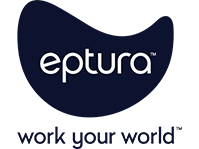
Organizations across industries will use AI to transform operations, according to Eptura’s 2025 Workplace Index report. 77% of buildings and facilities managers plan to implement AI in areas like employee experience and visitor management within the next 12 months, while 68% hope to use it to enhance security specifically. Just as important are all the ways employees can personalize AI tools to boost productivity in their individual workflows.
Welcome to our monthly deep dive into the trends and topics important to busy workplace and facility management (FM) professionals.
What is AI in the workplace?
AI applications in the workplace serve distinct purposes for facility managers and office employees, each tailored to their unique roles and responsibilities. For facility managers, AI is primarily for visitor management, space optimization, facilities automation, and preventive maintenance. These applications help enhance security, improve operational efficiency, and reduce costs by predicting and preventing equipment failures and optimizing resource allocation.
Office employees benefit from AI through seamless check-ins, better space utilization, and access to real-time information about their environment, such as temperature and noise levels. AI-embedded workflows improve their comfort and productivity, making their interactions with the workplace more intuitive and efficient.
Current workplace AI applications
In our opinion, Gartner’s “Predicts 2025: Empowering Workers With Intelligent Applications” explores the ways employees already use AI.
Earlier research cited in the report shows high AI tool adoption rates. According to Gartner®, “49% of respondents in the 2024 Gartner Digital Worker Survey use everyday AI tools or applications for work purposes.” Employees can use AI tools to automate routine tasks, provide real-time insights, and offer personalized recommendations. For example, AI-driven chatbots can assist with scheduling, answering common questions, and providing quick access to information, reducing the time employees spend on administrative tasks. Adopting AI tools enhances productivity and allows employees to focus more on strategic and creative work.
The 2025 report also has interesting insights into where and how employees are using AI.
Digital workers aged 18 to 25 distribute their working time more evenly across various devices, including laptops at a desk, desktop computers, personal devices, laptops away from their desk, mobile devices provided by work, and virtual desktops, according to the report. There’s a shift towards more flexible and device-agnostic work practices, which makes sense in a modern work environment, where employees often need to work from multiple locations and devices.
According to the research: “Fifty-one percent of digital workers reported customizing or building digital tools to assist their work, while the remaining 49% report using only the digital tools provided to them by IT.” Employees can tailor their work environment to their specific needs, improving their efficiency and job satisfaction. For example, they can create custom workflows, automate repetitive tasks, and integrate different applications to streamline work processes.
The future of AI in the workplace
The Gartner report also includes ideas on the future roles of AI. The report predicts that “by 2028:
- 80% of digital workers will use multimodal interfaces with generative AI, significantly improving task efficiency and workplace accessibility.
- 30% of business role job descriptions will require low-code or no-code skills as non-IT teams increasingly develop applications and automate process workflows. 20% of digital workers will create tools for themselves and their teammates to manage the noise from embedded intelligence in workplace applications.”
Taken together, these statistics and predictions highlight how employees are finding ways to personalize the ways they leverage AI to best match their workflows, roles, and responsibilities.
Spaces are tailored for success, too
Customization counts in physical spaces, too. A space that reflects the company’s values and mission can create a more cohesive and meaningful environment for employees. When the design aligns with the company’s culture, it can enhance productivity by creating an environment that supports the way employees work. For example, a collaborative culture might benefit from open spaces and meeting areas, while a more focused culture might require more private workspaces.
A workspace that reflects the company’s culture can also reinforce the brand identity both internally and externally. Consistency can help build a strong brand image and attract the right talent, while visitors and clients can also benefit from a space that aligns with the company’s culture, as it can enhance their perception of the brand and the company’s values.
In the Workplace Innovator podcast episode “’The Art of the Possible’ – Evolving Workplace Designs and the Role of Technology in Creating Innovative Spaces,” Pendrick Brown, managing director for EMEA and principal at HLW, describes a design practice that starts with a close look at company culture.
“We really want to get under the skin of the company we’re working with to really understand their culture, really understand their ethos,” Brown says. The goal is to design spaces that are not only unique but also future proof because they match the company’s long-term goals and evolving needs.
His design teams are also looking at other rich sources of data, including tracking trends across spaces for different types of companies. “Our clients are always asking us what else is out there, what do other companies do? So, we have that information at our fingertips, but our question back is, we don’t want to tell you what your competitors are doing. We want to learn from you what you’re doing, and then how do we translate that into the best design for your people, your ethos, your culture,” Brown explains.
Experience can be individualized, too
Workplace leaders should embrace the hospitality mindset to improve employee experience, according to Ashleigh Fiora, vice president and head of strategy and sales at Striden, in “’Partnering for Excellence’ – Empowering People by Delivering Facility Management Hospitality Services.”
By treating employees with the same level of care and personalized attention typically reserved for hotel guests, companies can foster a sense of belonging and appreciation. This can include providing comfortable and well-equipped spaces and offering amenities that make the workday more enjoyable. For example, well-stocked kitchens, comfortable lounges, and even wellness programs can all contribute to a more positive and engaging work environment. When employees feel valued and supported, they are more likely to be engaged and motivated, leading to higher productivity and better job performance.
Because people come into the office for new reasons, it’s an opportunity to change roles as well, says Fiora. “Receptionists now are elevated to a concierge role, setting up Wi-Fi, taking your jacket, maybe they are escorting you personally to your host, getting you set up in whatever conference room you have.”
Stay on top of the trends in intelligent worktech and facility management
Workplace and facility management are constantly evolving with new technologies, regulations, and best practices. Industry professionals always have something new to learn.
For more videos, podcasts, and webinars to keep you updated on the latest trends, visit Eptura’s resource page.
Gartner, Predicts 2025: Empowering Workers With Intelligent Applications, 15 January 2025
GARTNER is a registered trademark and service mark of Gartner, Inc. and/or its affiliates in the U.S. and internationally and is used herein with permission. All rights reserved.








